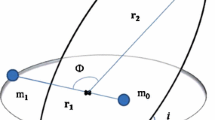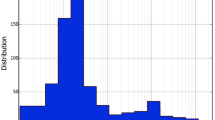Abstract
An exoplanet, or extrasolar planet, is a planet that does not orbit the Sun, but is around a different star, stellar remnant, or brown dwarf. Up to now, about 1900 exoplanets were discovered. To better understand the dynamics of these exoplanets, a study with respect to possible collisions of the planet with the central star is shown here. We present an expanded model in a small parameter that takes into account up to the fifth order to analyze the effect of this potential in the orbital elements of the extrasolar planet. Numerical simulations were also performed using the N-body simulations, using the software Mercury, to compare the results with the ones obtained by the analytical model. The numerical simulations are presented in two stages: one considering the celestial bodies as point masses and the other one taking into account their dimensions. This analysis showed that the planet collided with the central star in the moment of the first inversion for orbits with high inclinations in various situations. The results of the simulations of the equations developed in this study are consistent with the N-body numerical simulations. We analyze also the flip of the inclination taking into account the coupling of the perturbations of the third body, effect due to the precession of periastron and the tide effect. In general, we find that such perturbations combined delay the time of first inversion, but do not keep the planet in a prograde or retrograde orbit.

















Similar content being viewed by others
References
Beaugé C, Feraz-Mello S, Michtchenko TA (2012) Multi-planet extrasolar systems detection and dynamics. Res Astron Astrophys 12(8):1044–1080
Carvalho JPS, Vilhena de Moraes R, Prado AFBA, Winter OC (2013) Analysis of the secular problem for triple star systems. J Phys Conf Ser (Print) 465:1–6. doi:10.1088/1742-6596/465/1/012010
Carvalho JPS, Vilhena de Moraes R, Prado AFBA, Winter OC (2015) Exoplanets in binary star systems: on the switch from prograde to retrograde orbits. Celest Mech Dyn Astron. doi:10.1007/s10569-015-9650-3
Chambers JE (1999) A hybrid symplectic integrator that permits close encounters between massive bodies. Mon Not R Astron Soc 304:793–799
Correia ACM, Boué G, Laskar J (2012) Pumping the eccentricity of exoplanets by tidal effect. APJL 744(L23):1–5
Correia ACM, Boué G, Laskar J, Morais MHM (2013) Tidal damping of the mutual inclination in hierarchical systems. Astron Astrophys 553(A39):1–15
Eggleton PP, Kiseleva-Eggleton L (2001) Orbital evolution in binary and triple stars, with an application to SS Lacertae. ApJ 562:1012–1030
Ford EB, Kozinsky B, Rasio FA (2000) Secular evolution of hierarchical triple star systems. Astrophys J 535:385–401
Ford EB, Kozinsky B, Rasio FA (2004) Secular evolution of hierarchical triple star systems. Astrophys J 605:401–966
Harrington R (1969) The stellar three-body problem. Celest Mech 1:200–209
Kovalevsky J (1967) Introduction to celestial mechanics. Bureau des Longitudes, Paris, p. 126
Kozai Y (1962) Secular perturbations of asteroids with high inclination and eccentricity. Astron J 67(9):591
Laskar J, Boué G (2010) Explicit expansion of the three-body disturbing function for arbitrary eccentricities and inclinations. A&A 522(A60):1–11
Li G, Smadar Naoz S, Kocsis B, Loeb A (2014) Eccentricity growth and orbit flip in near-coplanar hierarchical three-body systems. Astrophys J 785(116):1–8
Lidov ML (1962) The evolution of orbits of artificial satellites of planets under the action of gravitational perturbations of external bodies. Planet Space Sci 9:719–759
Lidov ML, Ziglin SL (1976) Non-restricted double-averaged three body problem in Hill’s case. Celest Mech 13:471–489
Lithwick Y, Naoz S (2011) The eccentric Kozai mechanism for a test particle. ApJ 742(94):1–8
Liu B, Muñoz DJ, Lai D (2014) Suppression of extreme orbital evolution in triple systems with short range forces. arXiv:1409.6717
Naoz S, Farr WM, Lithwick Y, Rasio FA, Teyssandier J (2011) Hot Jupiters from secular planet–planet interations. Nature 473:187–189
Naoz S, Farr WM, Rasio FA (2012) On the formation of hot Jupiters in stellar binaries. Astrophys J Lett 754(L36):1–6
Naoz S, Farr WM, Lithwick Y, Rasio FA, Teyssandier J (2013) Secular dynamics in hierarchical three-body systems. MNRAS 431:2155–2171
Szebehely V (1989) Adventures in celestial mechanics. University of Texas Press, Austin
Valtonen M, Karttunen H (2006) The three-body problem. Cambridge University Press, Cambridge
Yokoyama T, Santos MT, Gardin G, Winter OC (2003) On the orbits of the outer satellites of Jupiter. Astron Astrophys 401:763–772
Acknowledgments
Sponsored by CNPq—Brazil. The authors are grateful to CNPq (National Council for Scientific and Technological Development)—Brazil for contracts 306953/2014-5, 304700/2009-6, 303070/2011-0, FAPESP (Foundation to Support Research in So Paulo State) under the contracts No. 2011/05671-5, 2012/21023-6, 2014/06688-7, 2011/08171-3, 2011/13101-4 SP-Brazil and CAPES.
Author information
Authors and Affiliations
Corresponding author
Additional information
Communicated by Dr. Elbert E. N. Macau, Dr. Antônio Fernando Bertachini de Almeida Prado and Dr. Cristiano Fiorilo de Melo.
Rights and permissions
About this article
Cite this article
Carvalho, J.P.S., de Moraes, R.V., Prado, A.F.B.A. et al. Analysis of the orbital evolution of exoplanets. Comp. Appl. Math. 35, 847–863 (2016). https://doi.org/10.1007/s40314-015-0270-z
Received:
Revised:
Accepted:
Published:
Issue Date:
DOI: https://doi.org/10.1007/s40314-015-0270-z




